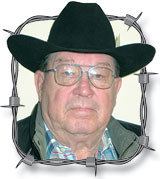We’ve had marvelous weather for January. This must be what old timers called “Oat Planting Time.” There was always some time period when you could get in and plant oats. Old timers told me when they farmed back in the past that there was a strain of oats that you could plant in the fall and make it through any hard winter.
I came to the Ozarks in the fall of 1960. My partner, Monty Smith, and I, being what people considered cowboys from Arizona, got a million dollars worth of advice. The fields we’d cleared of large persimmons that winter and needed to be planted to something beside broomsedge.
So we decide to plant about 3 or 4 acres of oats to make hay. For $5 we bought a horse drawn sulky disc at an auction. Hooked that implement to a team of logging mules and went to scratching the earth on weekends and evenings after teaching school. They said it was a good field and oats just needed to be planted – we were told oats would do fine. Well the oats never got over two inches high, it proved to be a good lesson for the two of us – like farming in Arizona you had to have fertilizer to grow anything.
The following year we planted 10 acres of oats with fertilizer, nitrogen and phosphate because it was low and potash. When we mowed it that year the oats were waist high and green as a gourd. One old man who worried about us all the time, came down and bragged on it. He then said, “Of course you cheated and used fertilizer.” From that day on, by his terms, we cheated at farming.
We bought a truckload of lime to spread on two small fields. I had a purpose but never told the “farm inspectors” that came all the time to give those Arizona Cowboys advice. I knew that limestone could change the pH of the soil and you could grow some legumes and I read more in my soils book than I did taking the course because that was never a problem in Arizona, so they didn’t teach it. We had put 5 acres in crimson clover, which I held the cows back on grazing it hoping it would reseed itself. The first year it looked wonderful. The entire field looked like a red blanket. That following year my stand wasn’t as successful at reseeding as I had hoped.
Now those old timers had gotten bulk lime dumped out of a dump truck at their family farm from the ASC or whatever they called it back then. As sons of famers they had to reload it on a wagon and spread it with shovels over the field. That burned them out on using lime and after that bitter experience I knew why they had no love for lime and saw no real use for it in agriculture.
Years later we used one of those spring-tooth renovators and worked 4 acres with it until it was on the frame. This land had been farmed to death and abandoned to broomsedge. We put four tons of lime to the acre and in two cuttings of red clover that year got over 500 good size bales of straight clover hay. Sold it in the barn to a dairyman for $3 a bale when fescue hay brought 50 cents that next winter.
I tried that same treatment with alfalfa and I don’t think we got any to come up. So all stories don’t work out as well as others. God bless America, you and your family, Dusty Richards






